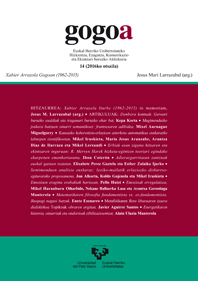Erbiak esan ziguna hitzaren eta ekintzaren inguruan
##plugins.themes.bootstrap3.article.main##
##plugins.themes.bootstrap3.article.sidebar##
Argitaratua
2016-02-17
Ibon Coteron
Laburpena
If words and actions have been joined by any philosophical research, this one is precisely Speech Act Theory. One of its topics is that verbal mood is a marker of illocutionary force. The transparent morphological structure of Basque verbs gives us the perfect choice to test it. For instance, the form nengo (S.1SG.stay.NPRS) would be a non-grammatical one, but it becomes a grammatical form supplied with one or another among some affixes: banengo(ba-nengo, if-S.1SG.stay.NPRS), nengoke (nengo-ke, S.1SG.stay.NPRS-COND), nengoen(nengo-en, S.1SG.stay.NPRS-PST). Similarly, near the non-grammatical form *gaitez(S.1PL.INTR.AUX.NIND.PRS), we have the correct bagaitez (ba-gaitez, if-S.1PL.INTR.AUX.NIND.PRS), gaitezke (gaitez-ke, S.1PL.INTR.AUX.NIND.PRS-POT) and gaitezen (gaitez-en, S.1PL.INTR.AUX.NIND.PRS-HORT/SBJV). At a first insight we would say that such affixes as the suppositive ba-, the consequential and conjectural -(te)ke and the past/hortative/subjunctive -n belong to one and the same semantic dimension, and really this is so. Contrary to what might be expected, the concepts useful for explaining these facts are not those of the most known version of Speech Act Theory (Searle's ones), but those others, mostly forgot aside, proposed by R. Mervyn Hare. Nevertheless, at some point they need an important supply of accuracy. The used version and its advantages are going to be exposed briefly in this article.
Nola aipatu
Coteron, I. (2016). Erbiak esan ziguna hitzaren eta ekintzaren inguruan. Gogoa, 14. https://doi.org/10.1387/gogoa.15630
##plugins.themes.bootstrap3.article.details##
Atala
Artikuluak

